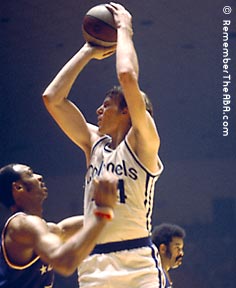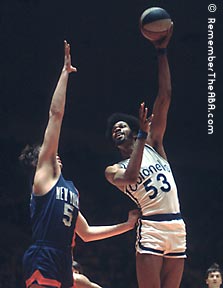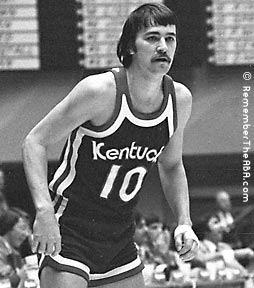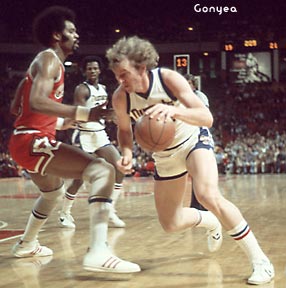Remember the ABA: Kentucky Colonels (original) (raw)
Back to "Remember the ABA" Main Page
Did you see a Kentucky Colonels game? Or, did you have a favorite Colonels player? Contribute to this web page by describing your favorite ABA Colonels memories.
The Kentucky Colonels were one of the ABA's most exciting teams and they still evoke sentimental feelings from their loyal Louisville fans. During the early years of the ABA, the Colonels were known more for their eye-catching green uniforms, their unique dog mascot, and their bizarre promotions than championship basketball. In 1968, they put the first female professional basketball player on the court in a real game (if only briefly). But as the years went on, the Colonels became a dominant ABA team. In fact, many observers believe that the later Colonels teams, anchored by Artis Gilmore in the middle, would have dominated most NBA teams. By the time the ABA folded in 1976, the Colonels had won the most regular season games in ABA history.
During their first four years of existence ("pre-Gilmore"), the Colonels posted a nondescript regular season record of 167-157. During that same period, they were a disappointing 21-22 in the playoffs. In those early years, some memorable Kentucky players were Goose Ligon, Sam Smith, George Tinsley, and Bobby Rascoe. The two brightest stars on the Kentucky roster, of course, were guards Louie Dampier and Darel Carrier. Both Dampier and Carrier were prolific three-point bombers. During their first three seasons together, the two combined to score an average of more than 50 points per game. Kentucky opponents prepared special defenses just to contain the long-range shooting of this pair. Recently, both Dampier and Carrier were named to the 30-Man ABA All-Time Team.
 Beginning in the 1970-71 season, Dampier and Carrier were no longer required to shoulder the team's scoring burden. This was due to the fact that the Colonels managed to sign All-American Dan Issel (at right, shooting over Zelmo Beaty) out of the University of Kentucky. Issel chose to play near his college stomping grounds and never seriously considered playing for the NBA team that halfheartedly drafted him in the eighth round, the Detroit Pistons. Issel was a pure scoring machine and topped in ABA in scoring average during his rookie year (29.9 ppg).
Beginning in the 1970-71 season, Dampier and Carrier were no longer required to shoulder the team's scoring burden. This was due to the fact that the Colonels managed to sign All-American Dan Issel (at right, shooting over Zelmo Beaty) out of the University of Kentucky. Issel chose to play near his college stomping grounds and never seriously considered playing for the NBA team that halfheartedly drafted him in the eighth round, the Detroit Pistons. Issel was a pure scoring machine and topped in ABA in scoring average during his rookie year (29.9 ppg).
During Issel's first year, the Colonels remained unimpressive during the regular season, going only 44-40. Along the way, the team went through three different coaches, finally settling on Frank Ramsey. However, the team's offensive punch became very effective when the playoffs came around. In the first round, in a series that is now largely forgotten, the Colonels faced the rejuvenated Floridians. The Floridians, under their new coach Bob Bass, had won seven straight games up to the final game of the regular season to barely clinch the Eastern Division's final playoff spot with a record of 42-42. The Floridians had two quick, small, high-scoring guards (Mack Calvin and Larry Jones), and they matched up well against the Colonels' Dampier and Carrier. In retrospect, Game 1 at Freedom Hall was probably where the Colonels won this surprisingly competitive series. Dampier hit a 10-foot jumper with 24 seconds left to play (and Mike Pratt hit two free-throws with the game already decided) to give the Colonels a 116-112 come-from-behind victory. For the rest of the series, the home team continued to win each game until Game 6, when Kentucky finally put away the pesky Floridians, 112-103, at the Miami Beach Convention Hall. In the next series, the Colonels faced the Eastern Division champions, the Virginia Squires, and high-scoring rookie Charlie Scott. Despite the fact that the Colonels did not have the home-court advantage, the series was not as competitive as the previous one. Kentucky prevailed in 6 games and moved on to face the Utah Stars for the ABA title.
The 1971 ABA Championship Series was a back-and-forth affair, with the home team holding serve in each successive game. In the first two games played in Salt Lake City, the Stars crushed the Colonels by scores of 136-117 and 138-125. But the Colonels knotted the series in Louisville by beating the Stars in Games 3 and 4. After the series became a best two-out-of-three affair, the remaining games became extremely physical and intensely competitive. The Colonels stayed close to the Stars in Game 5 at the Salt Palace, but the Stars prevailed again. Then, in Game 6 at Freedom Hall, Utah appeared to have the championship clinched, holding a 100-95 lead with less than four minutes remaining. But Cincy Powell hit a jumper and Louie Dampier hit a three-point play to knot the score at 100-all. After that, the Colonels hit free throws to go ahead, and pulled out an emotional 105-102 victory in front of a raucous crowd. The Colonels were confident going into the decisive Game 7 in Salt Lake City, but Goose Ligon, Kentucky's most consistent defensive player, was hampered by a back injury. Behind a 41-point game from Dan Issel and a 20-point/19-rebound effort from Powell, the Colonels stayed even with Utah through most of the game. But they simply ran out of time, as the talented Stars (and their fans) overran Kentucky in the 4th quarter. After the final buzzer, it took 30 minutes to clear the court of the hundreds of rabid Utah fans who had come down from the stands to celebrate the Stars' 131-121 victory.
 The next season, the Colonels' front office made a move that guaranteed that the team would be a perennial ABA championship contender. Kentucky signed Artis Gilmore (at left, #53), the best center in the college draft. At 7'1", Gilmore was the most intimidating center in the ABA. His strength was legendary and when he slam dunked, other players cringed under the basket for fear of being injured by the ball after it flew through the basket. With Gilmore in the fold as a rookie, and Joe Mullaney at the helm as coach, the team achieved an unbelievable 68-16 record during the 1971-72 season. Gilmore played in all 84 games that season, and averaged 23.8 points and 17.8 rebounds per game. To no one's surprise, he was named the ABA's overall MVP (over another spectacular rookie, Virginia's Julius Erving). Despite their all-time ABA-record win total in the regular season, Kentucky faltered in the playoffs. In a shocking upset, the Colonels lost in the very first round to Rick Barry, John Roche, and the surprising New York Nets, 4 games to 2. The Colonels' 1972 playoff failure gave rise to a three-year series of questions regarding the team's ability to play under intense playoff pressure. This led to a continual turnover of coaches, each carrying the heavy burden of ABA title expectations.
The next season, the Colonels' front office made a move that guaranteed that the team would be a perennial ABA championship contender. Kentucky signed Artis Gilmore (at left, #53), the best center in the college draft. At 7'1", Gilmore was the most intimidating center in the ABA. His strength was legendary and when he slam dunked, other players cringed under the basket for fear of being injured by the ball after it flew through the basket. With Gilmore in the fold as a rookie, and Joe Mullaney at the helm as coach, the team achieved an unbelievable 68-16 record during the 1971-72 season. Gilmore played in all 84 games that season, and averaged 23.8 points and 17.8 rebounds per game. To no one's surprise, he was named the ABA's overall MVP (over another spectacular rookie, Virginia's Julius Erving). Despite their all-time ABA-record win total in the regular season, Kentucky faltered in the playoffs. In a shocking upset, the Colonels lost in the very first round to Rick Barry, John Roche, and the surprising New York Nets, 4 games to 2. The Colonels' 1972 playoff failure gave rise to a three-year series of questions regarding the team's ability to play under intense playoff pressure. This led to a continual turnover of coaches, each carrying the heavy burden of ABA title expectations.
The next two years (1972-73 and 1973-74) were extremely frustrating years for the franchise, despite the team's continued on-court success during the regular season. In 1972-73, the Colonels won 56 games. Then, they knocked off Virginia and Carolina in the playoffs. The Virginia series was an interesting one because it pitted Dan Issel and Artis Gilmore of the Colonels against Julius Erving and George Gervin of the Squires. Three of these four players (Issel, Erving and Gervin) have been inducted into the Basketball Hall of Fame (and Gilmore has only narrowly missed this honor at the present time). Most observers thought that Virginia would give the Colonels some trouble, but Kentucky shut the door on the Squires, 4 games to 1. The Carolina series was simply a grueling war. The Eastern Division champion Cougars had Billy Cunningham (another future Hall-of-Famer), Mack Calvin, Joe Caldwell, and the all-important home-court advantage. In short, the Cougars were expected to advance to their first ABA Championship Series. Still, Kentucky nipped Carolina, 4 games to 3, in a series that went the distance.
 Game Action: Indiana Pacers at Kentucky Colonels, 1973 ABA Finals Game 1 (4/28/1973)
Game Action: Indiana Pacers at Kentucky Colonels, 1973 ABA Finals Game 1 (4/28/1973)
(streaming RealAudio File -- copyright Van Vance/WHAS-AM and used with permission)
At this point, the Colonels appeared to be on the verge of capturing their first ABA title. But the Indiana Pacers and George McGinnis had other plans. For the second straight series, the Colonels were involved in a seven-game marathon. In Game 1 of the 1973 ABA Finals, the Pacers served notice that they were, indeed, the defending ABA Champions. In a game filled with physical play and controversial calls (two Kentucky points were taken off the scoreboard after the referees huddled and determined that a 30-second violation had occurred), the Pacers took the Colonels to overtime in Freedom Hall and won 111-107. Kentucky did manage to recapture the home court advantage by winning Games 2 and 3. But the Colonels never really regained control of the series. In the decisive Game 7 at Freedom Hall, the Pacers beat Kentucky 88-81. The Kentucky starters in that 7th game were Gilmore, Issel, Walt Simon, Rick Mount and, of course, Dampier.
In July 1973, the franchise was almost sold to a group from Cincinnati. But Ellie and John Y. Brown (of Kentucky Fried Chicken and Democratic Telethon fame) stepped in to buy a majority interest in the Colonels. Interestingly, Ellie Brown established an all-female board of directors for the franchise. The board launched an effective ticket-selling campaign across the state, which actually tripled season ticket sales for the 1973-74 season, and doubled overall attendance. The team itself, under new coach Babe "Magnolia Mouth" McCarthy, went 53-31 in the regular season. Again, Colonels fans expected that an ABA title would be in the offing. In the first round of the playoffs, Kentucky crushed the troubled Carolina Cougars, 4 games to 0. But in the second round, the Colonels had no answers for Julius Erving and the New York Nets. In Game 3 of that series, played at Freedom Hall, Erving hit an unbelievable fall-away bank shot at the final buzzer to win the game for the Nets (90-88) and give New York a 3-0 series lead. Erving's shot simply broke the Colonels' spirit. New York ran away with Game 4 (played at Lexington) and swept the series 4-0. Kentucky starters during that series were Issel, Jim Bradley, Gilmore, Chuck Williams, and Dampier.
 Game Action: 4/4/1975 New York Nets at Kentucky Colonels: One-Game Playoff for Eastern Division Title
Game Action: 4/4/1975 New York Nets at Kentucky Colonels: One-Game Playoff for Eastern Division Title
(streaming RealAudio File -- copyright Van Vance/WHAS-AM and used with permission)
Kentucky's 1974 playoff failure resulted in the dismissal of the respected McCarthy. The franchise was simply desperate to find the winning edge. The coach selected to step into this pressure-packed situation was Hubie Brown, who had previously been an assistant coach with the NBA's Milwaukee Bucks. Brown understood the expectations surrounding his hiring, and accepted the challenge. For most of the 1974-75 season, the Colonels were in second place in the Eastern Division, behind the ABA defending champion New York Nets. But, amazingly, Kentucky won 22 out of its last 25 regular season games, including 10 in a row to close the regular season. That was enough to tie the Colonels with the Nets for first place at 58-26. A special one-game playoff was played at Kentucky to determine the division champion. The red-hot Colonels beat the Nets, 108-99.
 Game Action: 5/15/1975 Indiana Pacers at Kentucky Colonels: ABA Finals Game 2--End of Regulation
Game Action: 5/15/1975 Indiana Pacers at Kentucky Colonels: ABA Finals Game 2--End of Regulation
(streaming RealAudio File -- copyright Van Vance/WHAS-AM and used with permission)
In the 1975 ABA Playoffs, the Colonels finally found redemption. The first two rounds posed no challenge to the Colonels, as Kentucky crushed the Memphis Sounds 4 games to 1, and then dismantled the cinderella Spirits of St. Louis 4 games to 1. In the 1975 ABA Finals, Kentucky's opponent was its familiar foe, the Indiana Pacers. This year, however, the ending was much different than in 1973. In Game 1, the Colonels blew out Indiana, 120-94. Game 2 was much closer, as the score was tied with 12 seconds to go. At that point, Kentucky inbounded the ball and went inside to Artis Gilmore, who threw in a close range shot to put the Colonels up by 2 with three seconds left. Amazingly, Indiana's Billy Keller managed to throw in a three-pointer at the buzzer. But after a few minutes of confusion, the referees ruled that Keller's shot had come too late, and awarded the victory to Kentucky. After this one close battle went Kentucky's way, the rest of series was not in doubt. The Colonels only lost one game in Indiana (Game 4). In Game 5, before 16,622 screaming fans in Freedom Hall, the Colonels knocked off the Pacers 110-105, to capture the series. After the final buzzer, almost all the fans in attendance stayed to celebrate, and saw Artis Gilmore win the ABA Playoff MVP award. Gilmore had dominated the lane throughout the playoffs. And with the scoring punch of Issel and Dampier, the Colonels had finally broken through. Other members of the 1975 ABA Champions were Wil Jones, Bird Averitt, Ted "the Hound" McClain, Marv Roberts, and Ron "the Plumber" Thomas.
 After Dan Issel (above left) and Artis Gilmore (above right) joined Louie Dampier (left) in 1970 and 1971, respectively, Kentucky became a perennial contender for the ABA title.
After Dan Issel (above left) and Artis Gilmore (above right) joined Louie Dampier (left) in 1970 and 1971, respectively, Kentucky became a perennial contender for the ABA title.
Issel was a prolific and feared scorer for the Colonels. His favorite gambit was to lure frustrated opponents (centers and forwards alike) out of the paint by hitting a few of his long range "Issel Missiles." Then, Issel would apply his famous head-fake and blow past these helpless opponents for easy driving layups. Issel played in six straight ABA All-Star games, earning MVP honors in the 1971-72 game played in Louisville.
Gilmore established himself early on as one of the most intimidating defensive forces in either league. The NBA team with his rights, the Chicago Bulls, only agreed to the NBA-ABA merger after receiving the number one pick in the ABA dispersal draft. The Bulls used that pick to select Gilmore.
The Colonels' last ABA season, 1975-76, began with disappointment and shock as the team sold fan favorite Dan Issel to the disorganized Baltimore Claws. Owner John Y. Brown explained the move as necessary to preserve the financial viability of the franchise. However, Colonels fans failed to understand why one of their homegrown heroes had to be sold off. To make up for the loss of Issel, the Colonels obtained all-star center Caldwell Jones in the San Diego Sails dispersal draft. After a few weeks with Jones playing the forward position, the Colonels decided that Jones did not fit well with Gilmore and the rest of the team, so Jones was shipped to the Spirits of St. Louis for second-year man Maurice Lucas. Also, in the middle of the season, Marv Roberts was traded to the Virginia Squires for Jan Van Breda Kolff and Johnny Neumann. With all the new faces, it took a while for Coach Brown's team to gain an identity. By the end of the season, though, the team was playing well, and many observers felt that Kentucky had an outside chance to defend its title. The Colonels first faced the Indiana Pacers in a first round "mini series." This series went to the wire and Kentucky barely prevailed 2 games to 1. Next, the Colonels faced the regular season champion Denver Nuggets in the ABA Semifinals. The Colonels gave the Nuggets all they could handle in an emotional, tight, seven-game series. Kentucky had several chances to take control of the series, but the Nuggets always seemed to regain their poise. In the last Colonels game ever, in Game 7, the Nuggets eliminated Kentucky 133-110.
It was clear to everyone that the Colonels had the talent and the fan support to join the NBA for the 1976-77 season. However, during the merger negotiations in June 1976, the NBA made it clear that it would accept only four ABA teams, not five. With Denver, San Antonio, New York and Indiana being the clear front-runners to make the cut, John Y. Brown decided that it was better to fold the team for cash, instead of continuing to fight. To the great disappointment of long-time Colonels fans, Kentucky was left out of the merger and the Colonel's players were placed in a special dispersal draft of ABA players (along with players from the Spirits of St. Louis). Artis Gilmore went to the Chicago Bulls (as the number one pick), Maurice Lucas went to the Portland Trail Blazers, Bird Averittt went to the Buffalo Braves, Wil Jones went to the Pacers, Jan Van Breda Kolff went to the Nets, and Louie Dampier went to the Spurs.
 Most ABA observers were shocked that the Colonels did not join the NBA for the 1976-77 season - it seemed inexplicable that this talented roster could be disbanded. Even thirty years later, some Louisville residents are still angry that the Colonels were left out in the cold. In the years after the merger, Colonels fans took solace in the fact that several of their favorite Colonels truly made it big in the NBA.
Most ABA observers were shocked that the Colonels did not join the NBA for the 1976-77 season - it seemed inexplicable that this talented roster could be disbanded. Even thirty years later, some Louisville residents are still angry that the Colonels were left out in the cold. In the years after the merger, Colonels fans took solace in the fact that several of their favorite Colonels truly made it big in the NBA.
Artis Gilmore (above left and right, #53) landed with the Chicago Bulls and made six NBA All-Star teams. Maurice Lucas (above right, #20) joined the Portland Trailblazers - and immediately became known as "The Enforcer" due to his physical play. He helped the Blazers to the 1976-77 title and made four NBA All-Star teams. And, Dan Issel (right, with the wild hair) stayed with the Denver Nuggets for the rest of his career - he scored 14,659 NBA points, boosting his pro total to an amazing 27,482 points - a total that is currently 7th best in pro history.
Colonels Fan Memories (Part 1)
Colonels Fan Memories (Part 2)
Colonels Fan Memories (Part 3)
In his March 2000 article, "It's Time for the A-Train to Make a Stop at the Hall," Brett Ballantini wonders why Artis Gilmore is still missing from the Hall of Fame.
Brett Ballantini's April 1999 interview with Dan Issel.
In September 1974, the Colonels hired Hubie Brown to coach the team to a long-awaited ABA Championship. During the 1974-75 regular season, Brown completely revamped the Colonels' offense. At first, Dan Issel and Artis Gilmore struggled to adjust. But by April 1975, both players were mentally ready to carry Kentucky to the title. Read about the transformation of the Colonels in Dan Pattison's article "Has Big A Decided Enough Is Enough?" (written just before the 1975 Playoffs).
Before 1975, Dan Issel and the Kentucky Colonels went together "like the Horse and Carriage, bread and butter, salt and pepper." But in October 1975, the Colonels shocked their fans by selling Issel to the Baltimore Claws for $500,000. A few weeks later, the disorganized Claws traded Issel to Denver, where he played for nine straight years. How did Issel react to all of this upheaval at the time? Read "Issel and the Nuggets" by Dan Pattison.
The 1974 Colonels Prototype Uniform
COLONELS YEAR-TO-YEAR RESULTS
1967-68 Season
Record: 36-42, Tied for Fourth Place in Eastern Division
1968 Playoff Results:One Game Playoff at New Jersey Americans (36-42) for Fourth Place
Colonels won by Forfeit, 2-0, due to unplayable conditions1968 Western Division Semifinals vs. Minnesota Muskies (50-28)
Muskies won series, 3-2
1968-69 Season
Record: 42-36, Third Place in Eastern Division
1969 Playoff Results:Eastern Division Semifinals vs. Indiana Pacers (44-34)
Colonels lost series, 4-3
1969-70 Season
Record: 45-39, Second Place in Eastern Division
1970 Playoff Results:Eastern Division Semifinals vs. New York Nets (39-45)
Colonels won series, 4-3Eastern Division Finals vs. Indiana Pacers (59-25)
Colonels lost series, 4-1
1970-71 Season
Record: 44-40, Second Place in Eastern Division
1971 Playoff Results:Eastern Division Semifinals vs. Floridians (37-47)
Colonels won series, 4-2Eastern Division Finals vs. Virginia Squires (55-29)
Colonels won series, 4-2ABA Championship vs. Utah Stars (57-27)
Colonels lost series, 4-3
1971-72 Season
Record: 68-16, First Place in Eastern Division
1972 Playoff Results:Eastern Division Semifinals vs. New York Nets (44-40)
Colonels lost series, 4-2
1972-73 Season
Record: 56-28, Second Place in Eastern Division
1973 Playoff Results:Eastern Division Semifinals vs. Virginia Squires (42-42)
Colonels won series, 4-1Eastern Division Finals vs. Carolina Cougars (57-27)
Colonels won series, 4-3ABA Championship vs. Indiana Pacers (51-33)
Colonels lost series, 4-3
1973-74 Season
Record: 53-31, Second Place in Eastern Division
1974 Playoff Results:Eastern Division Semifinals vs. Carolina Cougars (47-37)
Colonels won series, 4-0Eastern Division Finals vs. New York Nets (55-29)
Colonels lost series, 4-0
1974-75 Season
Record: 58-26, Tied for First Place in Eastern Division
1975 Playoff Results:One Game Playoff At Louisville vs. New York Nets (58-26) for First Place in Eastern Division
Kentucky won 108-99Eastern Division Semifinals vs. Memphis Sounds (27-57)
Colonels won series, 4-1Eastern Division Finals vs. Spirits of St. Louis (32-52)
Colonels won series, 4-1ABA Championship vs. Indiana Pacers (45-39)
Colonels won Championship, 4-1
1975-76 Season
Record: 46-38, Fourth Place
1976 Playoff Results:First Round Mini-Series vs. Indiana Pacers (39-45)
Colonels won series, 2-1Semifinals vs. Denver Nuggets (60-24)
Colonels lost series, 4-3